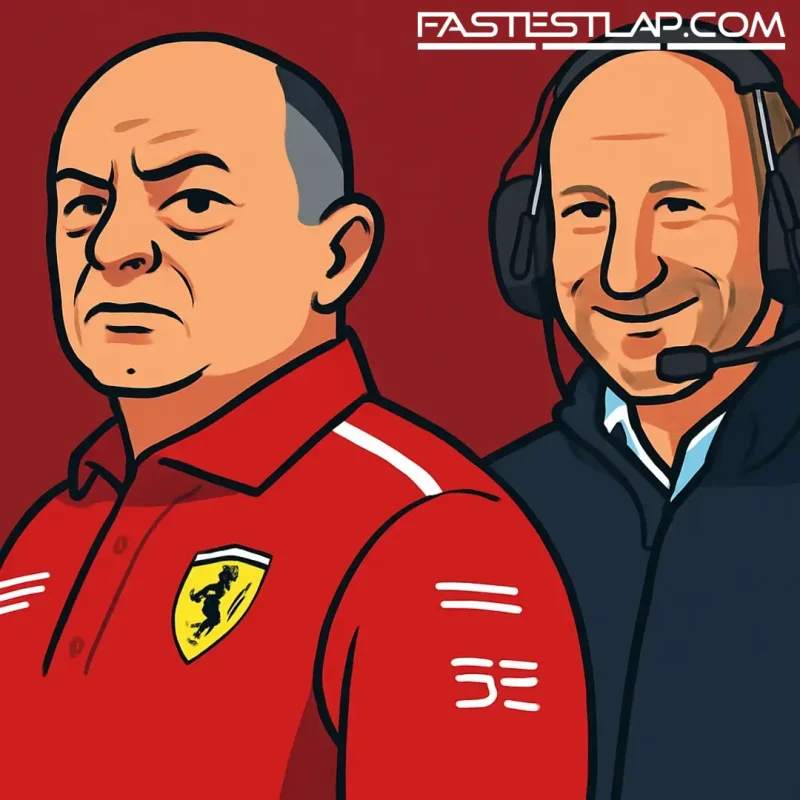Ferrari, Horner and the summer of noise: Why Vasseur isn’t going anywhere
Ferrari’s rumor mill has been working overtime, but the headline version — that Maranello is ready to jettison Fred Vasseur and install Christian Horner — doesn’t stack up with reality in the paddock. The short of it: Ferrari did sound out Horner earlier this year. The long of it: Vasseur’s seat isn’t on fire, and the door in Maranello isn’t the one Horner’s looking to walk through.
Let’s rewind. After missing last year’s Constructors’ title by just 14 points, Ferrari arrived into 2025 brimming with intent and a blockbuster driver pairing in Charles Leclerc and Lewis Hamilton. Eighteen rounds later, they’re winless. The SF-25’s chronic sensitivity to ride height has boxed them in, even forcing Ferrari to run the car higher — and slower — after Hamilton’s disqualification for excessive plank wear in China. It’s the sort of stubborn flaw that turns promising Sundays into long ones.
That form prompted the predictable summer chatter. In June, Italian headlines claimed Vasseur was on notice. Horner — then still steering Red Bull — was floated as a contender, alongside Ferrari sportscar chief Antonello Coletta. Before Horner’s shock exit from Milton Keynes in July, Ferrari did make an approach. That much is true.
But here’s the piece many missed: Ferrari were already moving to steady the ship. On the eve of the Hungarian Grand Prix, the team extended Vasseur on a multi‑year deal. CEO Benedetto Vigna called it a show of trust and accountability — and, crucially, everyone inside Maranello has operated since then as if Vasseur is leading the medium-term project.
The post-break slump kept the speculation alive, culminating in fresh German reports suggesting John Elkann was reconsidering. That’s not the signal coming out of Ferrari. The brief remains: fix the car’s operating window, keep the driver pairing aligned, and push through to the new rules. It’s not the posture of a team preparing a handover.
Vasseur, for his part, hasn’t been coy about the effect the noise has had. He admitted the Canadian GP rumor storm genuinely angered him, arguing it unfairly cast doubt over new technical hires and even triggered another cycle of Leclerc contract nonsense. Strip it back and the message is simple: the 2025 car’s concept was largely baked before the new recruits could influence it, and the back-page frenzy slowed rather than sped up the contract extension process.
So where does Horner fit into all this? He’s out at Red Bull after what’s been reported as a nine-figure settlement, and there’s an expectation he won’t be free to return to a pit wall until sometime in 2026. Even then, the smart money says he’s targeting equity, not a classic team-principal brief. That narrows the field immediately. Ferrari, a publicly traded giant with longstanding anchor shareholders, isn’t the place you go if you’re shopping for ownership. And for a man who spent 20 years building a dynasty on his terms, signing up for Ferrari’s famously impatient carousel — Vasseur is the fourth boss since 2014 — hardly screams “new chapter.”
None of this absolves Ferrari of their 2025 misfires. The SF-25’s platform has demanded compromises, the development path has been too conservative at times, and through it all McLaren and Mercedes have made bigger inroads on Sundays. But this isn’t a crisis of leadership as much as a crisis of concept. If Vasseur weathered a near-miss in 2024 and a dry spell in 2025, it’s because the project he inherited was always going to be multi-season and brutally exposed by new floors, stiffer ride targets and a car that doesn’t like to live low.
The bigger picture is 2026. That’s the reset button everybody cares about, from Maranello to Milton Keynes to Brackley. If Horner does reappear, it’ll likely be attached to ownership or a hybrid leadership structure elsewhere. If Ferrari make a change at the top, it won’t be because an impatient chairman blinked in October — it’ll be because the 2026 car misses the window and the strategic plan fails. That’s the line Vasseur’s working with, and the one he’s been backed to execute.
For now, ignore the melodrama. Ferrari kicked the tires on Horner when the opportunity arose — who wouldn’t? — and then doubled down on the guy they hired to bring coherence to the racing team. The SF-25 might not be a race-winner yet, but the guardrails in Maranello aren’t moving. And the man most likely to benefit from that stability is the same one already in the office.




